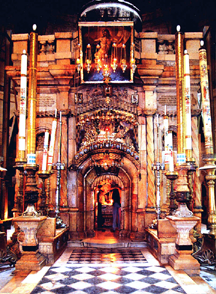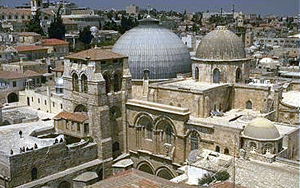|

An exploration of how and why places become invested with SACREDNESS and how the SACRED is embodied or made manifest through ART and ARCHITECTURE
HOLY SEPULCHRE, ISRAEL
The cave-like tomb (cf. The Sacred Cave) where Jesus Christ was buried in Jerusalem was allegedly discovered by Helena (St. Helena [see Helena and Jerusalem]), the mother of Emperor Constantine, on the site of a Roman temple dedicated to Venus. In 335 CE Constantine [see The Life of Emperor Constantine by Eusebius of Caesarea] erected a church over the spot (known to the Byzantines as Anastasis, or the Church of the Resurrection). Besides the Holy Sepulchre itself, the building also houses the Calvary or Golgotha where Christ was crucified. The church has since become one of Christianity's most sacred spots [see a plan of the church].
The building was a complex of monumental structures. It included a rotunda built over the tomb (recently restored), a great basilica, and columned courtyards. According to a 4th-century Christian tradition, it was at this site that Helena also found the true cross (cf. Trees and the Sacred).
The church was destroyed in successive wars, transformed in the Persian period, and finally rebuilt by the Crusaders [see The Church of the Holy Sepulcher in the Crusader Period].
 Tomb of Christ in the Church of the Holy Sepulchre According to the Gospels, close to the place here Christ was crucified was a new tomb hewn in the rock (cf. The Sacred Cave).
Joseph took the body, wrapped it in a clean linen cloth, and placed it in his own new tomb that he had cut out of the rock (Matthew. 27,59). Then he took it down, wrapped it in linen cloth and placed it in a tomb cut in the rock, one in which no one had yet been laid (Luke 23,53).
The entrance to the tomb was sealed by a stone (cf. The Sacred Stone), which is preserved and revered in the Angel's Chapel under the dome in the Church of the Holy Sepulchre.
When the Sabbath was over, Mary Magdalene, Mary the mother of James, and Salome bought spices so that they might go to anoint Jesus' body. Very early on the first day of the week, just after sunrise, they were on their way to the tomb and they asked each other, Who will roll the stone away from the entrance of the tomb? But when they looked up, they saw that the stone, which was very large, had been rolled away (Mark 16, 1-4).
On the first day of the week, very early in the morning, the women took the spices they had prepared and went to the tomb. They found the stone rolled away from the tomb, but when they entered, they did not find the body of the Lord Jesus (Luke 24,2).

The site of the crucifixion in the Church of the Holy Sepulchre The Gospels call the place where Christ was crucified Golgotha, which is an Aramaic word. The Greek term is Kranion, meaning skull. The name Calvary comes from the Latin root calva, referring to the scalp without hair. The common word Mount (i.e. Mount Calvary) is not used until the 4th century, when the surrounding rock was removed, leaving the rock of the crucifixion an isolated hill about 6 meters high. Although not a large hill, it nonetheless serves as a kind of mountain (cf. Mountains and the Sacred). Bibliography:
|
|






